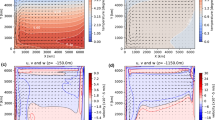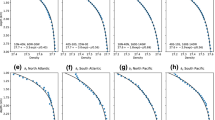Abstract
Using an idealized ocean general circulation model, we examine the effect of “mixing hotspots” (localized regions of intense diapycnal mixing) predicted based on internal wave-wave interaction theory (Hibiya et al., 2006) on the meridional overturning circulation of the Pacific Ocean. Although the assumed diapycnal diffusivity in the mixing hotspots is a little larger than the predicted value, the upwelling in the mixing hotspots is not sufficient to balance the deep-water production; out of 17 Sv of the downwelled water along the southern boundary, only 9.2 Sv is found to upwell in the mixing hotspots. The imbalance as much as 7.8 Sv is compensated by entrainment into the surface mixed layer in the vicinity of the downwelling region. As a result, the northward transport of the deep water crossing the equator is limited to 5.5 Sv, much less than estimated from previous current meter moorings and hydrographic surveys. One plausible explanation for this is that the magnitude of the meridional overturning circulation of the Pacific Ocean has been overestimated by these observations. We raise doubts about the validity of the previous ocean general circulation models where diapycnal diffusivity is assigned ad hoc to attain the current magnitude suggested from current meter moorings and hydrographic surveys.
Similar content being viewed by others
References
Adcroft, A., J. R. Scott and J. Marotzke (2001): Impact of geothermal heating on the global ocean circulation. Geophys. Res. Lett., 28, 1735–1738.
Bleck, R., C. Rooth, D. Hu and L. T. Smith (1992): Salinity-driven thermocline transients in a wind-and thermohaline-forced isopycnic coordinate model of the North Atlantic. J. Phys. Oceanogr., 22, 1486–1505.
Bryan, F. (1987): Parameter sensitivity of primitive equation ocean general circulation models. J. Phys. Oceanogr., 17, 970–985.
Brydon, D., S. Sun and R. Bleck (1999): A new approximation of the equation of state for seawater, suitable for numerical ocean models. J. Geophys. Res., 104, 1537–1540.
Cummins, P. F., G. Holloway and A. E. Gargett (1990): Sensitivity of the GFDL ocean general circulation model to a parameterization of vertical diffusion. J. Phys. Oceanogr., 20, 817–830.
Gaspar, P. (1988): Modeling the seasonal cycle of the upper ocean. J. Phys. Oceanogr., 18, 161–180.
Gregg, M. C. (1987): Diapycnal mixing in the thermocline: A review. J. Geophys. Res., 92, 5249–5286.
Gregg, M. C. (1989): Scaling turbulent dissipation in the thermocline. J. Geophys. Res., 94, 9686–9698.
Griffies, S. M., R. C. Pacanowski and R. Hallberg (2000): Spurious diapycnal mixing associated with advection in a z-coordinate ocean model. Mon. Wea. Rev., 128, 538–564.
Hasumi, H. and N. Suginohara (1999a): Effects of locally enhanced vertical diffusivity over rough bathymetry on the world ocean circulation. J. Geophys. Res., 104, 23367–23374.
Hasumi, H. and N. Suginohara (1999b): Atlantic deep circulation controlled by heating in the Southern Ocean. Geophys. Res. Lett., 26, 1873–1876.
Hibiya, T. and M. Nagasawa (2004): Latitudinal dependence of diapycnal diffusivity in the thermocline estimated using a finescale parameterization. Geophys. Res. Lett., 31, L01301, doi:10.1029/2003GL017998.
Hibiya, T., Y. Niwa, K. Nakajima and N. Suginohara (1996): Direct numerical simulation of the roll-off range of internal wave shear spectra in the ocean. J. Geophys. Res., 101, 14123–14129.
Hibiya, T., Y. Niwa and K. Fujiwara (1998): Numerical experiments of nonlinear energy transfer within the oceanic internal wave spectrum. J. Geophys. Res., 103, 18715–18722.
Hibiya, T., M. Nagasawa and Y. Niwa (2002): Nonlinear energy transfer within the oceanic internal wave spectrum at mid and high latitudes. J. Geophys. Res., 107, 3207, doi:10.1029/2002JC001376.
Hibiya, T., M. Nagasawa and Y. Niwa (2006): Global mapping of diapycnal diffusivity in the deep ocean based on the results of expendable current profiler (XCP) surveys. Geophys. Res. Lett., 33, L03611, doi: 10.1029/2005GL025218.
Huang, R. X. (1999): Mixing and energetics of the oceanic thermohaline circulation. J. Phys. Oceanogr., 29, 727–743.
Jackett, D. R. and T. J. McDougall (1995): Minimal adjustment of hydrographic profiles to achieve static stability. J. Atmos. Oceanic Technol., 12, 381–389.
Johnson, G. C. and J. M. Toole (1993): Flow of deep and bottom waters in the Pacific at 10°N. Deep-Sea Res., 40, 371–394.
Johnson, G. C., D. L. Rudnick and B. A. Taft (1994): Bottom water variability in the Samoa Passage. J. Mar. Res., 52, 177–196.
Ledwell, J. R., A. J. Watson and C. S. Law (1993): Evidence for slow mixing across the pycnocline from an open-ocean tracer release experiment. Nature, 364, 701–703.
Ledwell, J. R., E. T. Montgomery, K. L. Polzin, L. C. St. Laurent, R. W. Schmitt and J. M. Toole (2000): Evidence for enhanced mixing over rough topography in the abyssal ocean. Nature, 403, 179–182.
Levitus, S. and T. P. Boyer (1994): World Ocean Atlas 1994 Vol. 4, Temperature. NOAA Atlas NESDIS, U.S. Dep. of Commerce, Washington, D.C., 117 pp.
Levitus, S., R. Burgett and T. P. Boyer (1994): World Ocean Atlas 1994 Vol. 3, Salinity. NOAA Atlas NESDIS, U.S. Dep. of Commerce, Washington, D.C., 99 pp.
Marotzke, J. (1997): Boundary mixing and the dynamics of three-dimensional thermohaline circulations. J. Phys. Oceanogr., 27, 1713–1728.
McDermott, D. A. (1996): The regulation of northern overturning by southern hemisphere winds. J. Phys. Oceanogr., 26, 1234–1255.
McDougall, T. J. and W. K. Dewar (1998): Vertical mixing and cabbeling in layered models. J. Phys. Oceanogr., 28, 1458–1480.
Munk, W. (1966): Abyssal recipes. Deep-Sea Res., 13, 707–730.
Munk, W. and C. Wunsch (1998): Abyssal recipes II, Energetics of tidal and wind mixing. Deep-Sea Res., 45, 1977–2010.
Nagasawa, M., Y. Niwa and T. Hibiya (2000): Spatial and temporal distribution of the wind-induced internal wave energy available for deep water mixing in the North Pacific. J. Geophys. Res., 105, 13933–13943.
Nagasawa, M., T. Hibiya, Y. Niwa, M. Watanabe, Y. Isoda, S. Takagi and Y. Kamei (2002): Distribution of fine-scale shear in the deep waters of the North Pacific obtained using expendable current profilers. J. Geophys. Res., 107, 3221, doi:10.1029/2002JC001376.
Niwa, Y. and T. Hibiya (2001a): Numerical study of the spatial distribution of the M2 internal tide in the Pacific Ocean. J. Geophys. Res., 106, 22441–22449.
Niwa, Y. and T. Hibiya (2001b): Spatial distribution of the M2 internal tide in the North Pacific predicted using a three-dimensional numerical model. J. Geod. Soc. Jpn., 47, 711–718.
Park, Y.-G. and K. Bryan (2000): Comparison of thermally driven circulations from a depth-coordinate model and an isopycnal-layer model. Part I: Scaling-law sensitivity to vertical diffusivity. J. Phys. Oceanogr., 30, 590–605.
Polzin, K. L., J. M. Toole, J. R. Ledwell and R. W. Schmitt (1997): Spatial variability of turbulent mixing in the abyssal ocean. Science, 276, 93–96.
Roemmich, D., S. Hautala and D. L. Rudnick (1996): Northward abyssal transport through the Samoan passage and adjacent regions. J. Geophys. Res., 101, 14039–14055.
Rudnick, D. L. (1997): Direct velocity measurements in the Samoan Passage. J. Geophys. Res., 102, 3293–3302.
Saenko, O. A. and W. J. Merryfield (2005): On the effect of topographically enhanced mixing on the global ocean circulation. J. Phys. Oceanogr., 35, 826–834.
Schmitz, W. J., Jr. (1995): On the interbasin-scale thermohaline circulation. Rev. Geophys., 33, 151–173.
Scott, J. R. and J. Marotzke (2002): The location of diapycnal mixing and the meridional overturning circulation. J. Phys. Oceanogr., 32, 3578–3595.
Scott, J. R., J. Marotzke and A. Adcroft (2001): Geothermal heating and its influence on the meridional overturning circulation. J. Geophys. Res., 106, 31141–31154.
Simmons, H. L., S. R. Jayne, L. C. St. Laurent and A. J. Weaver (2004): Tidally driven mixing in a numerical model of the ocean general circulation. Ocean. Modell., 6, 245–263.
Sun, S., R. Bleck, C. Rooth, J. Dukowicz, E. Chassignet and P. Killworth (1999): Inclusion of thermobaricity in isopycnic-coordinate ocean models. J. Phys. Oceanogr., 29, 2719–2729.
Toggweiler, J. R. and B. Samuels (1995): Effect of Drake Passage on the global thermohaline circulation. Deep-Sea Res., 42, 477–500.
Toggweiler, J. R. and B. Samuels (1998): On the ocean’s large-scale circulation near the limit of no vertical mixing. J. Phys. Oceanogr., 28, 1832–1852.
Tsujino, H., H. Hasumi and N. Suginohara (2000): Deep Pacific circulation controlled by vertical diffusivity at the lower thermocline depths. J. Phys. Oceanogr., 30, 2853–2865.
Welander, P. (1971): The thermocline problem. Philos. Trans. Roy. Soc. London, 270A, 415–421.
Wijffels, S. E., J. M. Toole, H. L. Bryden, R. A. Fine, W. J. Jenkins and J. L. Bullister (1996): The water masses and circulation at 10°N in the Pacific. Deep-Sea Res., 43, 501–544.
Zhang, J., R. Schmitt and R. X. Huang (1999): The relative influence of diapycnal mixing and hydrologic forcing on the stability of the thermohaline circulation. J. Phys. Oceanogr., 29, 1096–1108.
Author information
Authors and Affiliations
Corresponding author
Rights and permissions
About this article
Cite this article
Endoh, T., Hibiya, T. Numerical study of the meridional overturning circulation with “mixing hotspots” in the Pacific Ocean. J Oceanogr 62, 259–266 (2006). https://doi.org/10.1007/s10872-006-0050-x
Received:
Revised:
Accepted:
Issue Date:
DOI: https://doi.org/10.1007/s10872-006-0050-x




